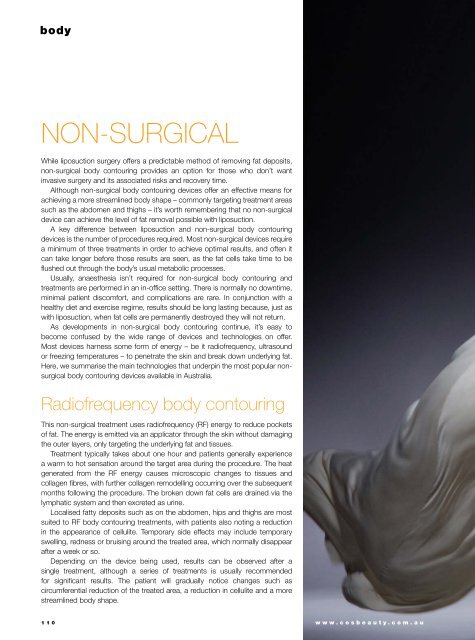Cosmetic Surgery and Beauty Magazine #66
Cosmetic Surgery and Beauty is the must-read for anyone considering a cosmetic procedure or treatment. With hundreds of before and after photo, and cosmetic and plastic surgery experts featured, tis educational resource will allow you to confidently decide the best course of action. This issue includes features on: Breast reshaping Six ways to get younger looking skin Surgical vs non-surgical fat reduction Body soothing products Energy boosters DIY perfect makeup As well as regular features on breast augmentation, facelifting, rhinoplasty and liposculpture/liposuction.
Cosmetic Surgery and Beauty is the must-read for anyone considering a cosmetic procedure or treatment. With hundreds of before and after photo, and cosmetic and plastic surgery experts featured, tis educational resource will allow you to confidently decide the best course of action.
This issue includes features on:
Breast reshaping
Six ways to get younger looking skin
Surgical vs non-surgical fat reduction
Body soothing products
Energy boosters
DIY perfect makeup
As well as regular features on breast augmentation, facelifting, rhinoplasty and liposculpture/liposuction.
Create successful ePaper yourself
Turn your PDF publications into a flip-book with our unique Google optimized e-Paper software.
ody<br />
NON-SURGICAL<br />
While liposuction surgery offers a predictable method of removing fat deposits,<br />
non-surgical body contouring provides an option for those who don’t want<br />
invasive surgery <strong>and</strong> its associated risks <strong>and</strong> recovery time.<br />
Although non-surgical body contouring devices offer an effective means for<br />
achieving a more streamlined body shape – commonly targeting treatment areas<br />
such as the abdomen <strong>and</strong> thighs – it’s worth remembering that no non-surgical<br />
device can achieve the level of fat removal possible with liposuction.<br />
A key difference between liposuction <strong>and</strong> non-surgical body contouring<br />
devices is the number of procedures required. Most non-surgical devices require<br />
a minimum of three treatments in order to achieve optimal results, <strong>and</strong> often it<br />
can take longer before those results are seen, as the fat cells take time to be<br />
flushed out through the body’s usual metabolic processes.<br />
Usually, anaesthesia isn’t required for non-surgical body contouring <strong>and</strong><br />
treatments are performed in an in-office setting. There is normally no downtime,<br />
minimal patient discomfort, <strong>and</strong> complications are rare. In conjunction with a<br />
healthy diet <strong>and</strong> exercise regime, results should be long lasting because, just as<br />
with liposuction, when fat cells are permanently destroyed they will not return.<br />
As developments in non-surgical body contouring continue, it’s easy to<br />
become confused by the wide range of devices <strong>and</strong> technologies on offer.<br />
Most devices harness some form of energy – be it radiofrequency, ultrasound<br />
or freezing temperatures – to penetrate the skin <strong>and</strong> break down underlying fat.<br />
Here, we summarise the main technologies that underpin the most popular nonsurgical<br />
body contouring devices available in Australia.<br />
Radiofrequency body contouring<br />
This non-surgical treatment uses radiofrequency (RF) energy to reduce pockets<br />
of fat. The energy is emitted via an applicator through the skin without damaging<br />
the outer layers, only targeting the underlying fat <strong>and</strong> tissues.<br />
Treatment typically takes about one hour <strong>and</strong> patients generally experience<br />
a warm to hot sensation around the target area during the procedure. The heat<br />
generated from the RF energy causes microscopic changes to tissues <strong>and</strong><br />
collagen fibres, with further collagen remodelling occurring over the subsequent<br />
months following the procedure. The broken down fat cells are drained via the<br />
lymphatic system <strong>and</strong> then excreted as urine.<br />
Localised fatty deposits such as on the abdomen, hips <strong>and</strong> thighs are most<br />
suited to RF body contouring treatments, with patients also noting a reduction<br />
in the appearance of cellulite. Temporary side effects may include temporary<br />
swelling, redness or bruising around the treated area, which normally disappear<br />
after a week or so.<br />
Depending on the device being used, results can be observed after a<br />
single treatment, although a series of treatments is usually recommended<br />
for significant results. The patient will gradually notice changes such as<br />
circumferential reduction of the treated area, a reduction in cellulite <strong>and</strong> a more<br />
streamlined body shape.<br />
110 www.cosbeauty.com.au

















